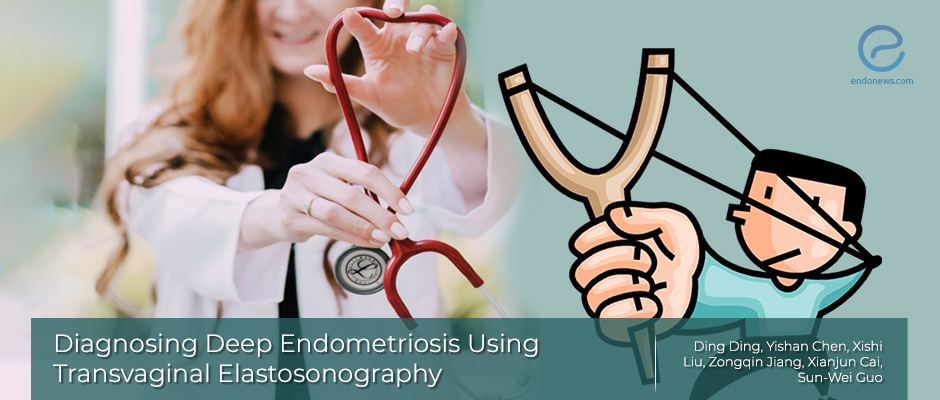Diagnosing Deep Endometriosis Using Transvaginal Elastosonography
Jun 25, 2020
Can Ultrasound Elastography be a new tool for Endometriosis Detection?
Key Points
Importance:
- What is transvaginal elastography and what benefit can it have in the work-up of endometriosis?
Highlights:
- Transvaginal elasto-sonography (TVESG) was found to be able to detect all lesions in a small patient population who were suspected to have deeply-infiltrating endometriosis (DIE).
- The authors believe TVESG may become an essential technique that can be used during TVUS for the diagnosis of endometriosis for improved detection.
What’s done here:
- This study assessed 30 patients suspected of having DIE and who underwent pelvic examination, TVUS and/or MRI, and TVESG in order to compare the accuracy of each technique with the histopathologic confirmation.
Key Results:
- The analysis failed to reach statistical significance when comparing the difference in stiffness among lesions that were failed to be detected by tri manual pelvic examination, TVUS, or MRI.
- Regardless of the detection method or their combinations, the authors found that the DIE lesions that evaded detection had a higher stiffness on average than those that were missed.
- There was no relationship between the location of DIE lesions and their stiffness, but this finding was limited by a small sample size.
- 16.7% of DIE cases were missed on tri manual pelvic examination and the lesions that were missed were significantly smaller than the remaining.
- TVUS detected 66.7%; MRI detected 83.3% of DIE lesions.
- The DIE cases, where usually lesion size was "small", and that were not diagnosed by TVUS or MRI were diagnosed by TVESG.
- Further studies are needed that aim to assess the sensitivity and specificity of TVESG when compared to TVUS alone and MRI alone.
Limitations:
- Unclear if the two ultrasound physicians who were involved in both TVUS and TVESG assessment were blinded when assessing endometriotic lesions.
- Unclear how the authors chose which patients to undergo MRI.
- There was a wide range in DIE lesion age, suggested by the wide range in values found during TVESG which limits comparison analysis.
- Over half of the recruited DIE patients also had adenomyosis which could have accounted for the failure of authors to find an association between lesion stiffness and severity of dysmenorrhea.
Lay Summary
Deeply infiltrating endometriosis (DIE) is an advanced form of endometriosis that causes significant morbidity to a large number of women. Early detection of endometriosis is imperative for early treatment and improved outcomes for these patients. Currently, transvaginal ultrasound (TVUS) and magnetic resonance imaging (MRI) are two of the main imaging modalities used to diagnosis DIE. Due to its lower cost and ease of use, TVUS is usually the first-line imaging modality in the work-up of women with pelvic pain and suspected endometriosis.
Elastosonography (ESG) is a technique used to measure a tissue's stiffness. ESG is now being studied for the diagnosis of endometriosis because the pathophysiology of endometriotic lesions is centered around repeated tissue injury and repair that causes fibrotic changes through multiple processes including smooth muscle metaplasia, fibroblast-to-myofibroblast transdifferentiation, and epithelial-mesenchymal transition. Two forms of ESG exist; namely strain imaging and shear-wave imaging which require mechanical excitation (palpation) of the lesion by applying pressure and propagating shear-waves through the lesion, respectively. The extent of fibrosis in DIE lesions is hypothesized by the study's authors to correlated with lesional stiffness and thus may provide insight on how advanced the lesion is.
The authors hypothesized that because adenomyotic and endometriotic lesions experience a similar pathophysiologic process of fibrosis, TVESG may also provide similar imaging benefits in the diagnosis of the endometriotic lesions.
This study, written by Ding et al, and published recently in "Reproductive Sciences" included 30 premenopausal patients with histologically confirmed DIE after undergoing excision surgery or in the case of endometrioma and/or adenomyosis who underwent cystectomy and/or hysterectomy. All patients were initially evaluated by a gynecologist (history, tri manual examination) and underwent TVUS. 24/30 (80%) patients also underwent MRI in addition to TVUS. Patients who were diagnosed with DIE by either TVUS or MRI and those who had symptoms suspicious of DIE but had negative imaging results also underwent TVESG. This was done to both compare the accuracy of each imaging technique but also assess the utility of TVESG for patients who ultimately did suffer from DIE but had negative TVUS or MRI results. All lesions detected during imaging were biopsied for histopathologic correlation.
5/30 (16.7%) cases of DIE were missed on tri manual pelvic examination was significantly smaller than the remaining cases. TVUS detected 20/30 (66.7%); MRI detected 20/24 (83.3%) of DIE lesions. All DIE cases that were not diagnosed by TVUS or MRI were diagnosed by TVESG. There was no relationship between the location of DIE lesions and their stiffness. The severity of dysmenorrhea was not correlated with stiffness or with lesion size, however, the severity of dysmenorrhea was associated with the enlarged uterine size.
While analysis failed to reach statistical significance when comparing the difference in lesional stiffness among lesions that were failed to be detected by trimanual pelvic examination, TVUS, or MRI, authors found that regardless of the detection method or their combinations, the DIE lesions that evaded detection had a higher stiffness on average than those that were missed. When authors divided the stiffness of these lesions into "low" (kPa<100) and "high" (kPa >100) groups, they found that there was a statistically significant difference in the lesional staining of E-cadherin, alpha-SMA, ER-beta, and progesterone receptor, the extent of fibrosis, and vascular density between these two groups.
Thus, TVESG is a novel imaging technique that may hold promise as a definitive, adjunctive tool alongside TVUS for the detection of endometriosis. However, further studies are needed to confirm the results of this study.
Research Source: https://pubmed.ncbi.nlm.nih.gov/32333226
ultrasound elastography endometriosis pain imaging MRI

